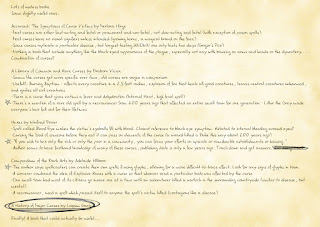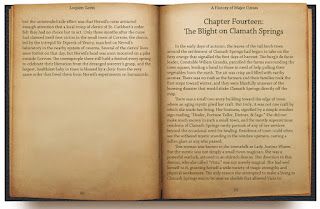We're jumping into the deep stuff right away in this post, apparently. Following a summary of the session, I'm going to talk about my method for developing NPCs and how to place them into a campaign without planning ahead. As a side note, the player who controls Gerald wasn't able to join us until midway through the session, so Gerald's having run off on his own was an easy way to deal with his player's absence.
At the end of the previous session, Gerald had run away to be by himself; Ell had gone with Fiskar and Ren the mysterious elf to get dessert and wine; Carric and Dez had returned to Gilly at the Temple of Pelor's Grace. We began with Carric and Dez. Gilly was surprised that another person was interested in the plague, and the group discussed what little information they had. Gilly asked them to obtain a book from the royal library about diseases. Carric cast Detect Poison/Disease on a plague victim and discovered that it registers as positive on a spell detecting disease as well as for magic. Carric and Dez then headed for a prestigious school called the Worley Academy of Arts and Sciences.
Meanwhile, Ell, Fiskar, and Ren arrived at The Purple Stocking and enjoyed fine wines and desserts. The three assassins/bounty hunters/whatever term you choose discussed their shared profession in veiled terms. Ren described Clan Born at Night, a collective he created. The group of bounty hunters he works and lives with are his family, he told them. He then asked to speak with Fiskar alone. Ell went outside and watched their conversation from a covert position, but wasn't able to discern what was said. Fiskar left the bar, and Ell joined up with him. Fiskar tried to describe Ren and then divulged information about the fall of Talon Gorge, a huge city to the north. Fiskar produced an ornate chess piece (the bishop) and gave it to Ell, explaining that he had pilfered it from the palace as parts of the city crumbled. They returned to their motel and went to their respective rooms to sleep.
Back at the academy, Dez and Carric began investigating. Carric interviewed the professor of magic during class, asking if he knew anything about the plague or whether there were any children in the academy he worried about. The professor said that a student of his had gone missing a few months before. Dez talked to a student in time out, Cedric. They discussed his favorite books, his love of fiddling with magic and with glyphs*, and his sister, who had gone missing a few months before. (This probably makes it look like I was railroading them into a storyline. I hope the players didn't take it that way. It just made sense to me that two people in the same small community would both mention something about a big, scary loss.) Together, Dez and Carric spoke with Headmistress Rootblancher - but not without being tricked by Cedric into thinking the Headmistress was a man, causing an awkward laugh from most involved. The Headmistress offered some information on the missing girl, Edwinna. Classes ended for the night, and Dez and Carric left the academy with Cedric to walk him home and gather more information.
*Glyphs are a system of casting magic that I created for my podcasted campaign. The basic idea is that the 200 or so symbols I developed each correspond to a small set of concepts, like "Air/Sky/Wind," "Strong/Powerful/Potent," or "Deception/Lying/Misinformation." Casting a spell involves combining these glyphs to create a customized spell. The difficulty is that the magical energy is less tamed than with traditional casting, so a spell can be "misunderstood," so to speak; the glyphs may not combine in the way the caster thinks, and the results can be disastrous. All this is to say that a seven-year-old boy is not exactly the best candidate for fiddling with this chaotic, unpredictable magic.
 |
| A brief illustration of glyph-based casting. |
Gerald's player arrived, and he took Gerald right back to The Bleeding Crown for more drinks. He struck up a conversation with the bartender, an orc named Brom. Brom offered advice on making friends, and Gerald tried making friends with the gnome sitting next to him, Spindle. The attempt did not go well, as Gerald scared and frequently insulted Spindle. After talking more about friends, Gerald decided to go try to find Carric, Dez, or Ell.
At a street corner in the northwest corner of the city, Carric, Dez, Cedric, Ell, and Gerald converged. (I will totally admit that this was some lazy railroading. The party was cool with it, though, and they went forward without questioning it.) Updates were exchanged on what had happened since they'd last met, and before too long, Cedric began talking about seeing the dead. Ghosts floated out of the darkness from all around them. They fought the ghosts and kept Cedric protected, destroying the majority of the ghosts and capturing two of them with a magical barrier. They questioned the ghosts a bit before leaving to take Cedric home.
As I said before, I'm happy with this session. I have begun to lay out multiple options for the players to consider, and I've been able to start adding more information and more depth to the areas that they'll already shown interest in. This has all been done on the fly. It becomes easier to be flexible when you haven't planned in advance, so the improvisation has really made it easy to focus on player interest. But how do you add NPCs to a game without coming up with a reason for them to be there? I want to share my process for developing NPCs (or rather, that process in part - I want to dedicate a full post, coming soon, to the information I focus on when developing a character) and getting them into an improvised campaign.
My NPC creation process usually starts with me reading something or hearing a song that seems to crystallize a thought or feeling perfectly. I choose the song as a character theme and then start building a character who is the best approximation of what someone would be like if ruled by the thought or feeling. Details get added (again, more details on this process in a future post), and the character takes shape. Adding them to the campaign requires a little patience.
I'll use as an example here an NPC who has not yet been introduced to the players. The NPC's name is Erys Wynne, and Erys is a talented, self-sufficient treasure hunter. She's cautious - she has a half dozen aliases to keep people from targeting her, for instance. She's smart - her companion is a robotic homunculus she built herself, and she's a fairly expert wizard. She's daring - she's raided some of the most dangerous tombs and best hundreds of foes (even though she never kills those who she fights). Erys is a fun character I salvaged from a campaign that never quite made it past the third session or so. As much as I want her in the mix right now, there's no reason that she would want to contact anyone in the party, nor would she be involved with any of the events that the group has gotten up to. So there are now options available for introducing Erys: one, the group's adventures lead them into something involving treasure hunting, or two, another NPC wants to introduce the group to her. I figure that option one is great if it comes up, but I doubt it will. Even if it did happen, I'd be spoiling the group's attempt to actually raid a tomb and get rewarded for it by including an expert who would either help or thwart them. Option two is the better hope.
When you want to introduce an NPC, I stand by the "I know a person" method. When a player discusses what goals they have with an NPC, figure out if its possible that this NPC they're speaking to knows the NPC you want to bring into the campaign. If the answer is no, that's fine. You want it to make sense that the NPCs know each other. There will be other chances later. But your NPC might come up in conversation as the skilled person who may be useful or as the person who was in the right place at the right time and knows something important. This is exciting to the players - they have a potential lead on an issue they're paying attention to. The NPC you're introducing will have their full attention. Give the new character a bit of an intro (theatrical intros can be a lot of fun), and make sure there are allusions to how this NPC is special, but don't throw in much backstory. People don't meet each other and start swapping life stories in detail right away, and your NPC probably shouldn't either. By offering some tantalizing and incomplete information, you'll pique your players' interests and leave them curious about the NPC.
Remember that you have some leeway when it comes to adding your NPCs. For Erys, I like the idea of a bounty hunter knowing her because of occasional professional overlap, but Erys could just as easily be referred if the players need an obscure academic or magical text to be identified, if they need a guide into dangerous ruins, or if they need to know about secret passages somewhere. Erys is also a musician (a drummer and vocalist), so they could also encounter her at a tavern where she would be performing. When you enter a situation where the NPC could be, it's easy to drop them in and see if they take. If the players don't quite take to the NPC, let them leave that character alone for now and see if a future appearance has better luck. If the players never seem interested in an NPC, don't be afraid to discard them. There may be a better place for them in a future campaign, and forcing them on players doesn't make for a great experience for the players.
That's all for this time. Look out for more about NPC development and document creation in future posts, as well as updates on the third session when that finally happens (five young adult schedules are quite a scheduling obstacle to contend with). Until then, happy gaming!
Back to the homepage (where you can find everything!)


